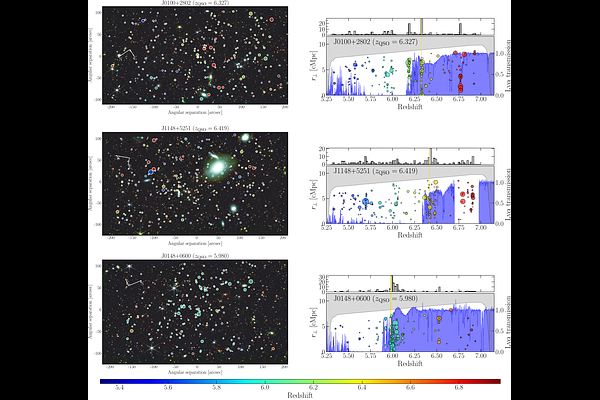EIGER VII. The evolving relationship between galaxies and the intergalactic medium in the final stages of reionization

EIGER VII. The evolving relationship between galaxies and the intergalactic medium in the final stages of reionization
Daichi Kashino, Simon J. Lilly, Jorryt Matthee, Ruari Mackenzie, Anna-Christina Eilers, Rongmon Bordoloi, Robert A. Simcoe, Rohan P. Naidu, Minghao Yue, Bin Liu
AbstractWe present a comprehensive analysis of the relationship between galaxies and the intergalactic medium (IGM) during the late stages of cosmic reionization, based on the complete JWST EIGER dataset. Using deep NIRCam $3.5\,\mathrm{\mu m}$ slitless spectroscopy, we construct a sample of 948 [\OIII]$\lambda5008$-emitting galaxies with $-21.4\lesssim M_\mathrm{UV}\lesssim -17.2$ spanning $5.33<z<6.97$ along six quasar sightlines. We correlate these galaxies with \Lya\ and \Lyb\ transmission measured from high-resolution quasar spectra across multiple redshift intervals. We find clear redshift evolution in the correlation between galaxy density and transmission: it is suppressed in overdense regions at $z<5.50$, while enhanced at $5.70<z<6.15$. The intermediate range exhibits a transitional behavior. Cross-correlation measurements further reveal excess absorption within $\sim 8$\,cMpc of galaxies at low redshifts, and enhanced transmission at intermediate scales ($\sim$5--20\,cMpc) at $z>5.70$. Statistical tests using mock catalogs with realistic galaxy clustering but no correlation with the transmission field confirm that the observed correlations are unlikely to arise by chance. The evolving signals can be explained by stronger absorption in overdense regions, combined with the competing influences of local radiation fields and the rising background radiation. While local radiation dominates ionization of the surrounding IGM at earlier times, the background becomes increasingly important, eventually surpassing the impact of nearby galaxies. These results support an inside-out progression of reionization, with ionized regions originating around clustered, star-forming galaxies and gradually extending into underdense regions.